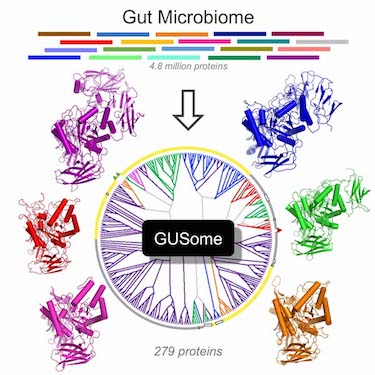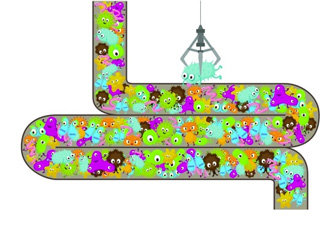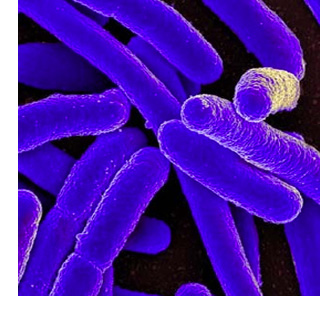
 Microbiome-encoded β-glucuronidase, GUS, enzymes play important roles in human health by metabolizing drugs in the gastrointestinal, GI, tract. The numbers, types, and diversity of these proteins in the human GI microbiome, however, remain undefined.
Microbiome-encoded β-glucuronidase, GUS, enzymes play important roles in human health by metabolizing drugs in the gastrointestinal, GI, tract. The numbers, types, and diversity of these proteins in the human GI microbiome, however, remain undefined.
Published in the journal Structure, researchers in the Redinbo Group, in collaboration with colleagues at the University of Florida, present an atlas of GUS enzymes comprehensive for the Human Microbiome Project GI database. The group members identify 3,013 total and 279 unique microbiome-encoded GUS proteins clustered into six unique structural categories. They assign their taxonomy, assess cellular localization, reveal the inter-individual variability within the 139 individuals sampled, and discover 112 novel microbial GUS enzymes. A representative in vitro panel of the most common GUS proteins by read abundances highlights structural and functional variabilities within the family, including their differential processing of smaller glucuronides and larger carbohydrates.
The information outlined in this study could form a basis for personalized medicine and predictive efforts to identify patients at risk for chemotherapy-induced diarrhea, for example. Such knowledge may facilitate regimen-tailoring to enhance anti-tumor efficacy while avoiding dose-limiting GI toxicities, or could suggest dietary changes that could improve microbiota composition before treatment.
Taken together, the data and methodologies presented provide a roadmap for the annotation of diverse microbiome-encoded catalytic and non-catalytic functions, and open the door to new eras of discovery in understanding mammalian-microbial mutualism.
 We humans are born alone. But that solitude is fleeting. Even as we emerge from the womb, we have started to accumulate the first few hundred of our lifelong companions - the rich population of microbes that live in and on us. By the time we greet our kindergarten teacher, we are outnumbered: The microbial cells we carry far exceed our own. These bugs are not freeloaders. We maintain a symbiosis with our microbiome that helps keep us healthy. Its job includes breaking down foods our bodies are otherwise unable to digest, metabolizing nutrients into needed vitamins, helping to regulate glucose levels, and sending signals to our immune system.
We humans are born alone. But that solitude is fleeting. Even as we emerge from the womb, we have started to accumulate the first few hundred of our lifelong companions - the rich population of microbes that live in and on us. By the time we greet our kindergarten teacher, we are outnumbered: The microbial cells we carry far exceed our own. These bugs are not freeloaders. We maintain a symbiosis with our microbiome that helps keep us healthy. Its job includes breaking down foods our bodies are otherwise unable to digest, metabolizing nutrients into needed vitamins, helping to regulate glucose levels, and sending signals to our immune system.
The cover story in the 09/28 issue of C&EN discusses the importance of understanding the "Hordes in the MIcrobiome," citing groundbreaking research from Carolina Chemistry professor Matthew Redinbo. The Redinbo Group found a way of alleviating a dangerous side effect of a colon cancer drug in mice, by blocking a bacterial enzyme, Chemistry & Biology, Volume 22, Issue 9, 17 September 2015, Pages 1238-1249. Irinotecan is one of just three drugs available to treat colon cancer, but it causes severe diarrhea that limits the doses patients can handle. Gut bacteria snip a sugar group off an irinotecan metabolite to generate a molecule that is thought to cause diarrhea. So researchers in the Redinbo Group and colleagues found a way to stop the sugar cleavage while not killing the bacteria, which are essential for good health.

There are microscopic communities living inside all of us. These communities are made up of bacteria that happily live on or inside our bodies. Each community is called a microbiome, and they orchestrate a carefully balanced two-way relationship. We give them a place to live, and they help keep certain tissues healthy. It is an important relationship, with damage to these unique ecosystems being linked to a number of diseases, including cancer. So keeping these communities healthy is a big deal. But last week, a team of US scientists offered a solution to one situation where these microbes are not so helpful. In a study published in the journal Chemistry & Biology, the team found new evidence that a particular group of microbes may be behind some nasty side-effects linked to bowel cancer chemotherapy. But, most importantly, there is also a potential way to limit these side-effects, using drugs that are already in development. And their findings reveal the targets of these drugs in unprecedented detail.
Studies like this are a great example of how scientists across the globe are doing more than just designing the next generation of treatments. We know that side-effects are a big deal for patients and their doctors. And regardless of whether we're talking about futuristic experimental treatments or long-standing chemotherapy drugs, understanding the potential side-effects - and finding ways to manage them - forms a crucial part of research. Much like the bacteria that help us stay healthy, the experience of cancer treatment is one that is shared by the patient, their family and the people who treat them. By viewing this as one working organism, we are in the best place to ensure cancer treatments are as safe and effective as patients need them to be.
Contact: Matt Redinbo; (919) 843-8910 office; (919) 962-7576 lab